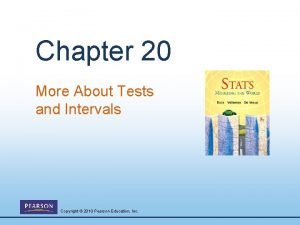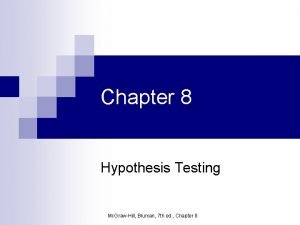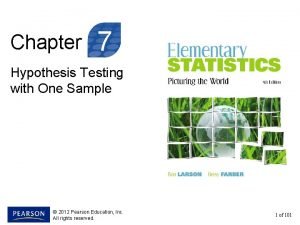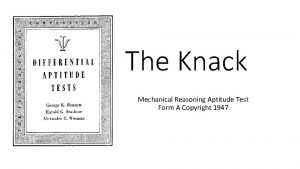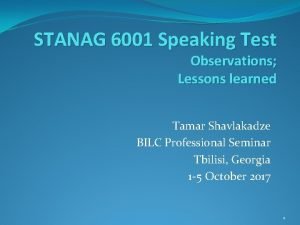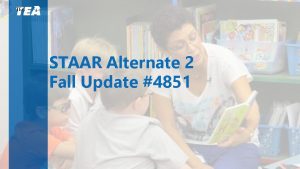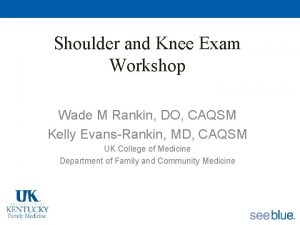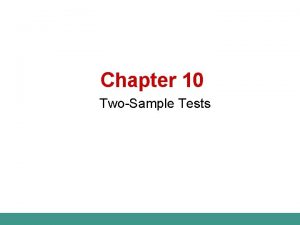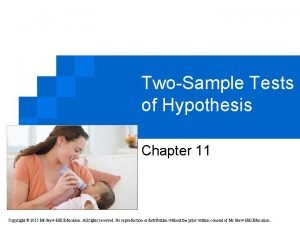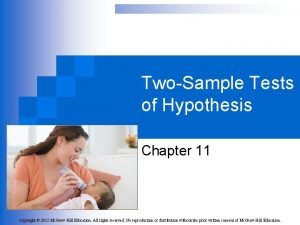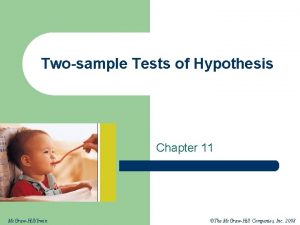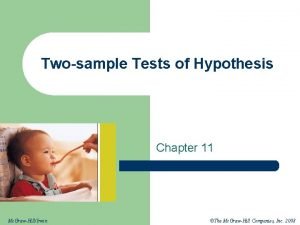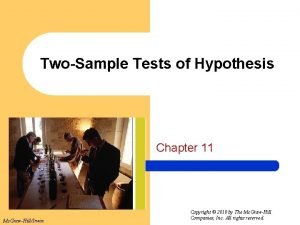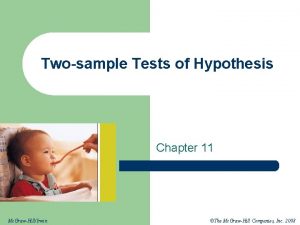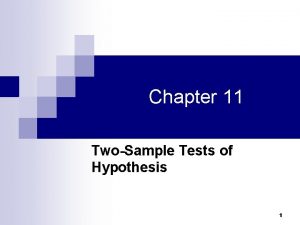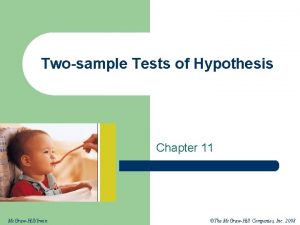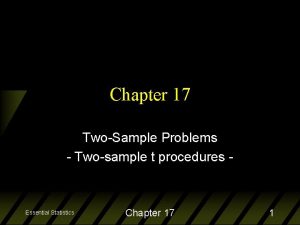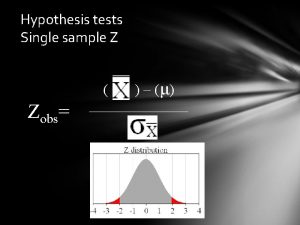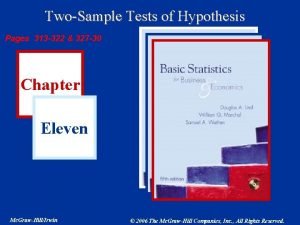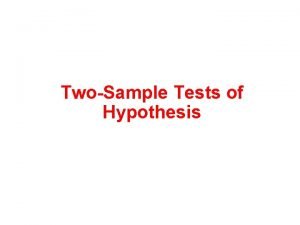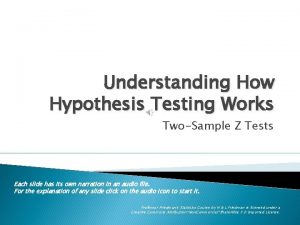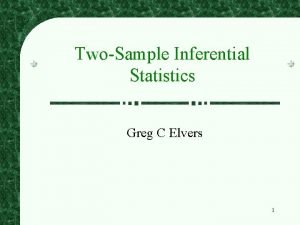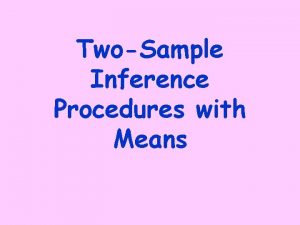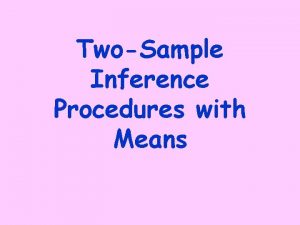TwoSample Tests of Hypothesis Chapter 11 Copyright 2015
























- Slides: 24

Two-Sample Tests of Hypothesis Chapter 11 Copyright © 2015 Mc. Graw-Hill Education. All rights reserved. No reproduction or distribution without the prior written consent of Mc. Graw-Hill Education.

Learning Objectives LO 11 -1 Test a hypothesis that two independent population means are equal, assuming that the population standard deviations are known and equal. LO 11 -2 Test a hypothesis that two independent population means are equal, with unknown population standard deviations. LO 11 -3 Test a hypothesis about the mean population difference between paired or dependent observations. LO 11 -4 Explain the difference between dependent and independent samples. 11 -2

Comparing Two Populations – Examples § Is there a difference in the mean value of residential real estate sold by male agents and female agents in south Florida? § Is there a difference in the mean number of defects produced on the day and the afternoon shifts at Kimble Products? § Is there a difference in the mean number of days absent between young workers (under 21 years of age) and older workers (more than 60 years of age) in the fast-food industry? § Is there is a difference in the proportion of Ohio State University graduates and University of Cincinnati graduates who pass the state Certified Public Accountant Examination on their first attempt? § Is there an increase in the production rate if music is piped into the production area? 11 -3

LO 11 -1 Test a hypothesis that two independent population means are equal, assuming that the population standard deviations are known and equal. Comparing Two Population Means: Equal, Known Population Variances § No assumptions about the shape of the populations are required. § The samples are from independent populations. § The formula for computing the value of z is: 11 -4

LO 11 -1 Comparing Two Population Means: Equal, Known Population Variances – Example The Fast Lane procedure was recently installed at the local food market. The store manager would like to know if the mean checkout time using the standard checkout method is longer than using the Fast Lane procedure. She gathered the following sample information. The time is measured from when the customer enters the line until their bags are in the cart. Hence, the time includes both waiting in line and checking out. What is the p-value? α=0. 01 11 -5

LO 11 -1 Comparing Two Population Means: Equal, Known Population Variances – Example Applying the six-step hypothesis testing procedure: Step 1: State the null and alternate hypotheses. (keyword: “longer than”) H 0 : µS ≤ µ F H 1 : µ S > µ F Step 2: Select the level of significance. The. 01 significance level is requested in the problem. Step 3: Determine the appropriate test statistic. Because both population standard deviations are known, we can use the z-distribution as the test statistic. 11 -6

LO 11 -1 Comparing Two Population Means: Equal, Known Population Variances – Example Step 4: Formulate a decision rule. Reject H 0 if z > z z > 2. 326 11 -7

LO 11 -1 Comparing Two Population Means: Equal, Known Population Variances – Example Step 5: Take a sample and make a decision. The computed value of 3. 123 is larger than the critical value of 2. 326. Our decision is to reject the null hypothesis. Step 6: Interpret the result. The difference of. 20 minutes between the mean checkout time using the standard method is too large to have occurred by chance. We conclude the Fast Lane method is faster. p-value=0. 5 -0. 4990=0. 0010 11 -8

LO 11 -2 Test a hypothesis that two independent population means are equal, with unknown population standard deviations. Comparing Population Means: Equal, Unknown Population Standard Deviations (The Pooled t-test) The t distribution is used as the test statistic. The required assumptions are: § Both populations must follow the normal distribution. § The populations must have equal standard deviations. § The samples are from independent populations. 11 -9

LO 11 -2 Comparing Population Means: Equal, Unknown Population Standard Deviations (The Pooled t-test) Finding the value of the test statistic requires two steps: 1. Pool the sample standard deviations. 2. Use the pooled variance to compute the t-statistic. 11 -10

LO 11 -2 Comparing Population Means: Equal, Unknown Population Standard Deviations (The Pooled ttest) – Example Owens Lawn Care, Inc. , manufactures and assembles lawnmowers that are shipped to dealers throughout the United States and Canada. Two different procedures have been proposed for mounting the engine on the frame of the lawnmower. The question is: Is there a difference in the mean time to mount the engines on the frames of the lawnmowers? The first procedure was developed by longtime Owens employee Herb Welles (designated “W”), and the other procedure was developed by Owens Vice President of Engineering William Atkins (designated “A”). To evaluate the two methods, it was decided to conduct a time and motion study. A sample of five employees was timed using the Welles method and six using the Atkins method. The results, in minutes, are shown on the right. Is there a difference in the mean mounting times? Use the. 10 significance level. 11 -11

LO 11 -2 Comparing Population Means: Equal, Unknown Population Standard Deviations (The Pooled t-test) – Example Step 1: State the null and alternate hypotheses. (Keyword: “Is there a difference”) H 0 : µW = µ A H 1 : µ W ≠ µ A Step 2: State the level of significance. The 0. 10 significance level is stated in the problem. Step 3: Select the appropriate test statistic. Because the population standard deviations are not known but are assumed to be equal, we use the pooled t-test. 11 -12

LO 11 -2 Comparing Population Means: Equal, Unknown Population Standard Deviations (The Pooled t-test) – Example Step 4: State the decision rule. Reject H 0 if t > t /2, n. W+n. A-2 or t < - t /2, n. W+n. A-2 t > t. 05, 9 or t < - t. 05, 9 t > 1. 833 or t < - 1. 833 11 -13

LO 11 -2 Comparing Population Means: Equal, Unknown Population Standard Deviations (The Pooled t-test) – Example Step 5: Compute the value of t and make a decision. (a) Calculate the sample standard deviations. (b) Calculate the pooled variance. 14 11 -14

LO 11 -2 Comparing Population Means: Equal, Unknown Population Standard Deviations (The Pooled t-test) – Example Step 5 (continued): Take a sample and make a decision. (c) Determine the value of t. The decision is not to reject the null hypothesis because -0. 662 falls in the region between -1. 833 and 1. 833. Step 6: Interpret the Result. The data show no evidence that there is a difference in the mean times to mount the engine on the frame between the Welles and Atkins methods. 11 -15

LO 11 -2 Comparing Population Means: Equal, Unknown Population Standard Deviations (The Pooled t-test) – Example 11 -16

LO 11 -3 Test a hypothesis about the mean population difference between paired or dependent observations. Comparing Population Means: Hypothesis Testing with Dependent Samples Dependent samples are samples that are paired or related in some fashion. For example: ¨ If you wished to buy a car you would look at the same car at two (or more) different dealerships and compare the prices. ¨ If you wished to measure the effectiveness of a new diet you would weigh the dieters at the start and at the finish of the program. 11 -17

LO 11 -3 Comparing Population Means: Hypothesis Testing with Dependent Samples Use the following test when the samples are dependent: Where is the mean of the differences sd is the standard deviation of the differences n is the number of pairs (differences) 11 -18

LO 11 -3 Comparing Population Means: Hypothesis Testing with Dependent Samples – Example Nickel Savings and Loan wishes to compare the two companies, Schadek and Bowyer, it uses to appraise the value of residential homes. Nickel Savings selected a sample of 10 residential properties and scheduled both firms for an appraisal. The results, reported in $000, are shown in the table (right). At the. 05 significance level, can we conclude there is a difference in the mean appraised values of the homes? 11 -19

LO 11 -3 Comparing Population Means: Hypothesis Testing with Dependent Samples – Example Step 1: State the null and alternate hypotheses. H 0 : d = 0 H 1 : d ≠ 0 Step 2: State the level of significance. The. 05 significance level is stated in the problem. Step 3: Select the appropriate test statistic. To test the difference between two population means with dependent samples, we use the t-statistic. 11 -20

LO 11 -3 Comparing Population Means: Hypothesis Testing with Dependent Samples – Example Step 4: State the decision rule. Reject H 0 if t > t /2, n-1 or t < - t /2, n-1 t > t. 025, 9 or t < - t. 025, 9 t > 2. 262 or t < -2. 262 11 -21

LO 11 -3 Comparing Population Means: Hypothesis Testing with Dependent Samples – Example Step 5: Take a sample and make a decision. The computed value of t, 3. 305, is greater than the higher critical value, 2. 262, so our decision is to reject the null hypothesis. Step 6: Interpret the result. The data indicate that there is a significant statistical difference in the property appraisals from the two firms. We would hope that appraisals of a property would be similar. 11 -22

LO 11 -3 Comparing Population Means: Hypothesis Testing with Dependent Samples – Excel Example 11 -23

LO 11 -4 Explain the difference between dependent and independent samples. Dependent versus Independent Samples How do we differentiate between dependent and independent samples? § Dependent samples are characterized by a measurement followed by an intervention of some kind and then another measurement. This could be called a “before” and “after” study. § Dependent samples are characterized by matching or pairing observations. Why do we prefer dependent samples to independent samples? § By using dependent samples, we are able to reduce the variation in the sampling distribution. 11 -24
 Ace different tests help iq but
Ace different tests help iq but Copyright 2015 all rights reserved
Copyright 2015 all rights reserved Copyright 2015 all rights reserved
Copyright 2015 all rights reserved What is an alternative hypothesis
What is an alternative hypothesis Alternative hypothesis
Alternative hypothesis Alternative hypothesis
Alternative hypothesis Nebular hypothesis and protoplanet hypothesis venn diagram
Nebular hypothesis and protoplanet hypothesis venn diagram Chapter 24 diagnostic tests and specimen collection
Chapter 24 diagnostic tests and specimen collection Chapter 20 more about tests and intervals
Chapter 20 more about tests and intervals Chapter 23 specimen collection and diagnostic testing
Chapter 23 specimen collection and diagnostic testing Chapter 8 hypothesis testing
Chapter 8 hypothesis testing Chapter 7 hypothesis testing with one sample answers
Chapter 7 hypothesis testing with one sample answers Year 4 mental maths tests
Year 4 mental maths tests Ap environmental science water test
Ap environmental science water test Romberga tests
Romberga tests Dirty minded test words
Dirty minded test words Number sense uil tricks
Number sense uil tricks Uil calculator practice tests
Uil calculator practice tests Mechanical reasoning aptitude test
Mechanical reasoning aptitude test Shrek meeting the mentor
Shrek meeting the mentor Univariate analysis tests
Univariate analysis tests Gravity seriousness
Gravity seriousness Staar alt 2 released test
Staar alt 2 released test Simple recall example
Simple recall example Rotator cuff tests
Rotator cuff tests








